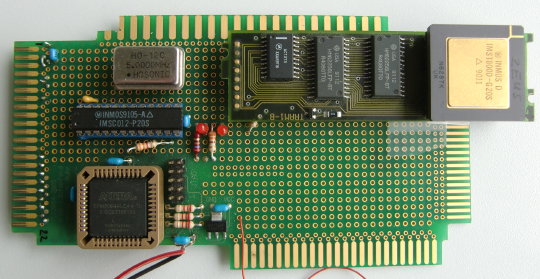So here we go, C64 first. Some moons ago I was at least midwife if not the mother of the 8BitBaby manufactured by the fairies and elves over at individual computers.
This little card features 4 slot-connectors to the most used home-computer systems as well as a CPLD… and makes a perfect basis for my first C64 “cartridge” ever 😉
The schematic was taken from “Das Transputerbuch” by U. Gerlach and being put into the CPLD saving lots of TTL chips. Actually all you need then is an Inmos C012 or C011 link-interface chip, a 5MHz oscillator and some resistors and caps.
I refrained from designing a complete Transputer system but went the easy route by interfacing to a TRAM. A TRAM is a complete “Transputer system on-a-stick”, like those used in my Tower of Power. All you need for a TRAM is an interface to your system. For the C64 you would need the thing I’ve called T2C64 (aka “Transputer to C64”)
The T2C64 prototype in its full glory:
A short overview what’s on the card:
- The left edge is the connector to the C64s expansion slot (ignore the other edges).
- The square black chip is the Altera CPLD mainly containing the bus-interface and the Transputer Analyze/Reset/Error signal handling. Ah, and it controls the 2 LEDs.
- The long black chip above the CPLD is an Inmos C012. This guy interfaces an 8bit parallel bus to the serial Inmos link ‘bus’.
- The silver thing is a 5MHz oscillator to clock the C012.
- And finally the longish module at the top edge is a TRAM with 128KB RAM and a mucho-macho T800 Transputer.
The CPLD maps the C012 register into the memory area of 0xde00, using just 6 addresses:
- Data in 0xde00
(56832) - Data out 0xde01
(56833) - in-status 0xde02
(56834) - out-status 0xde03
(56835) - reset/error 0xde08 (
56840) - analyse 0xde0c (
56844)
So programming it pretty easy, still, you have to read some Inmos manuals about the protocol etc… that said the next chapters will show you some code examples I’ve slapped together just to test the hardware. All sources and binaries (.D64 image) are available in a zip file over here, obviously most of that does not make sense without having a T2C64…
Read on in the next posts for demo-code and even a video. “uuh, videos!”

